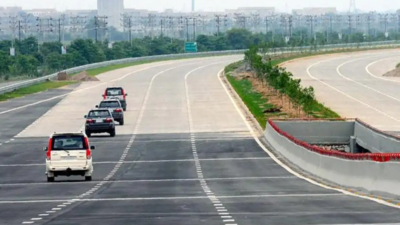- News
- City News
- noida News
- 2nd Noida expressway gets green light, will be built along Yamuna
Trending
2nd Noida expressway gets green light, will be built along Yamuna
Noida Authority has approved a proposal for a second expressway between Noida and Greater Noida to alleviate traffic congestion on the existing Noida Expressway. The new project could be an eight-lane ground expressway or a six-lane elevated road, with potential involvement from NHAI or a special purpose vehicle formed by local authorities.
NOIDA: Plans to build a second expressway between Noida and Greater Noida have firmed up after Noida Authority gave in-principle approval to the project at its board meeting last week after extensive discussions on its need, design and alignment.

A riverside bypass
You Can Also Check: Noida AQI | Weather in Noida | Bank Holidays in Noida | Public Holidays in Noida
On the table now are two lines of action – either an eight-lane ground expressway or a six-lane elevated road that runs along Yamuna's embankments between Okhla barrage (near Kalindi Kunj) and Yamuna Expressway.
Noida keen to bring in NHAI for new e-way along Yamuna
Noida is keen to bring in National Highways Authority of India (NHAI) for the new expressway but that will also mean designating the road as a national highway. Source said during the March 28 board meeting, chief secretary and board chair Manoj Kumar Singh suggested if the NHAI plan does not materialise, Noida, Greater Noida and Yamuna Expressway authorities should take the initiative to build the road.
Should this happen, one of the models under consideration involves forming a special purpose vehicle (SPV) by the three authorities, sources said.
City traffic has surged on Noida Expressway because of large-scale development of residential, industrial, institutional and commercial sectors on either side as well, and a population jump in Greater Noida after Covid. As a result, the expressway is congested through the day and has led to apprehension that it could meet the same fate as Delhi-Gurgaon expressway, which sees bumper to bumper traffic during morning and evening peak hours, unless a bypass is built.
Estimates suggest traffic volume will surge over the next few years because of the development planned to Noida's east, especially the airport in Jewar and industrial and housing projects in its influence area along Yamuna Expressway and in Greater Noida.
The proposed new expressway will extend from Okhla barrage to the Yamuna Expressway via the Hindon-Yamuna doab. The alignment, sources said, will take into consideration existing road infrastructure along the Yamuna marginal bund, an area which is currently within the jurisdiction of the irrigation department.
A four-lane road exists between Okhla barrage and the irrigation drain, which runs 11km. It runs parallel to key sectors, including 94, 124, 125, 126, 127, 128, 129, 130, 131, 132, 133, 134, and 135. After this, the Hindon-Yamuna doab bund road, which is 14km long, runs parallel to sectors like 150, 160, 162, 164, 165 and 167.
The new expressway will require carefully planned entry and exit points, loops, and underpasses. Sources said Sector 168 has been identified as a crucial point for an interchange with Faridabad-Noida-Ghaziabad (FNG) expressway. Similarly, at Sector 150, the new expressway will be linked to the main road between Sector 149A and Sector 150.
Noida Authority will need to conduct a comprehensive traffic survey and feasibility study before preparing a detailed project report (DPR). The DPR will finally decide whether the road will be a surface expressway or an elevated one.
A Noida expressway bypass was first proposed in Nov 2023. Noida Authority wanted NHAI to take up construction, but the latter had at that point expressed its inability to construct the road.
End of Article
Follow Us On Social Media









